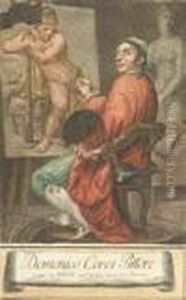Giovanni Paolo Lasinio Paintings
Giovanni Paolo Lasinio, born in 1759 in Rosignano Marittimo, Tuscany, Italy, was a distinguished Italian engraver and printmaker of the late 18th and early 19th centuries. His contribution to the world of art is notably marked by his dedication to preserving and documenting Italian Renaissance and Baroque artworks through his engravings. Lasinio’s work is characterized by its meticulous attention to detail and its faithfulness to the original masterpieces, making his engravings a valuable resource for the study of Italian art history.
Lasinio initially trained under his father, Carlo Lasinio, who was also an accomplished engraver. This apprenticeship provided him with a solid foundation in the arts, particularly in the techniques of engraving and etching, which he would later refine and master throughout his career. In the early stages of his career, Lasinio focused on producing prints after the works of earlier masters, which helped him to cultivate a keen eye for detail and a deep appreciation for the nuances of artistic styles.
One of Lasinio's most significant contributions to art history was his work at the Camposanto Monumentale in Pisa. In the early 19th century, he undertook the task of engraving the frescoes of this monumental cemetery, which were at risk of being lost due to exposure to the elements. His project, 'Pitture a fresco del Campo Santo di Pisa', published in 1812, documented these artworks in exquisite detail, preserving their imagery for future generations. This work not only highlighted his remarkable skill as an engraver but also underscored his commitment to the preservation of art.
Throughout his career, Lasinio was recognized for his expertise and dedication to the arts. He held the position of professor at the Academy of Fine Arts in Florence, where he influenced a generation of artists with his teachings on engraving and art history. His legacy includes not only his own artworks but also his contributions to the education of future artists and the preservation of Italian cultural heritage.
Giovanni Paolo Lasinio passed away in 1829, leaving behind a body of work that continues to be celebrated for its precision, beauty, and historical value. His engravings serve as a testament to the richness of Italian art and the importance of preservation efforts in the history of art. Through his dedication to capturing the essence of the works he reproduced, Lasinio has ensured that the splendor of Italy’s artistic achievements is accessible to art lovers and scholars around the world.
